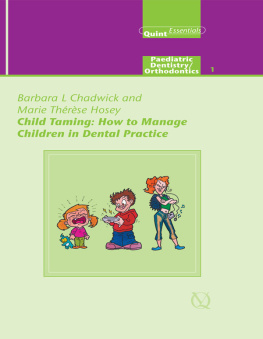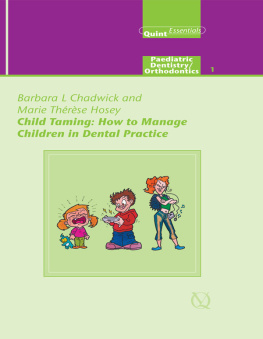
Quintessentials of Dental Practice 9
Paediatric Dentistry/Orthodontics 1
Child Taming
How to Manage Children in Dental Practice
Authors:
Barbara L Chadwick
Marie Thrse Hosey
Editors:
Nairn H F Wilson
Marie Thrse Hosey

Quintessence Publishing Co. Ltd.
London, Berlin, Chicago, Copenhagen, Paris, Milan, Barcelona, Istanbul, So Paulo, Tokyo, New Dehli, Moscow, Prague, Warsaw
British Library Cataloguing in Publication Data
Chadwick, Barbara L.
Child taming : how to manage children in dental practice. - (Quintessentials of dental practice ; 9. Paediatric dentistry/orthodontics ; 1)
1. Pedodontics 2. Children - Dental care
I. Title II. Hosey, Marie Thrse
617.645
ISBN 1850973067
Copyright 2003 Quintessence Publishing Co. Ltd., London
All rights reserved. This book or any part thereof may not be reproduced, stored in a retrieval system, or transmitted in any form or by any means, electronic, mechanical, photocopying, or otherwise, without the written permission of the publisher.
ISBN 1-85097-306-7
Acknowledgements
Dr Andrew Makin, Consultant Anaesthetist, for the paediatric anatomy and physiology; Caroline Campbell and Alison Cairns for their wonderful contribution to both the clinical photographs and commentary on the developing text; and finally, Jason Leitch, Graeme Wright and Ed Hosey for their help with the proof-reading.
A special thanks to Gail Drake in the Photography Department, Glasgow Dental Hospital and School and Jo Griffiths, Dental Illustration Unit, Dental School, Cardiff and finally and especially to all the children who agreed to model for us.
Foreword
The frightened, fractious, four-year-old, first-attendance child; the fussing, fraught, dentally frightened mother:
Sweetheart, its OK! The dentist the one in the white coat wont really hurt you. The injection will be worth it to get rid of that nasty toothache. Just hold tight on to the chair.
How well do you manage this sort of situation? Can you confidently sense what the child is thinking? How will she react to your approach? Is your practice child friendly? And are you up to date on consent, conscious sedation, and when and how to refer for treatment under general anaesthesia?
Child Taming: How to Manage Children in Dental Practice the ninth volume in the Quintessentials of Dental Practice series has been written to help the busy practitioner address these questions, and many more, for the best management of child patients. Possibly the nearest thing you will get to a ready reckoner to assess the level of anxiety of a child patient and provide advice for effective care. Well-presented (as you expect of Quintessence Publishing) and neatly packaged, in an easy-to-read style (as you would expect of the Quintessentials of Dental Practice series): an attractive package.
Have you met the kids in the cartoons? If you havent, they are bound to turn up in your practice sooner or later. Will you be prepared for them? If in doubt, this book is for you.
Nairn Wilson
Editor-in-Chief
Preface

The dental surgery is an alien place to a child. Strangers in crisp uniforms inhabit the inner sanctum, whilst other grown-ups sit or pace around waiting, looking weary or worried or frightened. There are strange smells, clinical colours and posters on the walls reminiscent of visiting the school sick bay, and shining, sharp-looking instruments lying out ready for use. Within the many drawers and cupboards other things are hidden... It is rumoured at school that dentists hurt. Grandparents have been telling some scary stories recently and parents had warned that you end up at the dentist when too much sugar is eaten. There are rules here that only the dentist and perhaps a few parents understand, but the child has still to learn them.
It is hardly surprising that dentistry provokes apprehension in children but there is no doubt that successfully managing children presents both the greatest challenge and the greatest reward for a dentist. This book is less about child taming and more about training the dental team and parents how to work together to ensure that a childs visit to the dentist is a pleasurable experience.
Childhood apprehension about dentistry is not limited to children in the United Kingdom. A study of 3,200 children in eight European countries (including the United Kingdom) found 35% of five-year-olds and 21% of 12-year-olds were fearful before visiting the dentist. Interestingly, the parents of 32% of five-year-olds and 30% of 12-year-olds across Europe reported that they too were fearful before a dental visit. This data suggests that anxiety is so prevalent that it should be considered normal. Indeed, making the assumption that the majority of patients may be suffering from some degree of anxiety might remind the dentist and their team to approach children, especially, in a sympathetic manner thereby enhancing the likelihood of a successful introduction to life-long dental care.
In this book we hope to give family dentists the keys to successful child management by showing how to:
create a child-friendly atmosphere
co-ordinate the whole dental team
communicate with children and their families
create a treatment plan conducive to child care
utilise behavioural management techniques
decide when and how to use conscious sedation and general anaesthesia
link with wider specialist and community services.
Chapter 1
Introducing the Children
Aim
In this chapter the stages of child development and individual personality will be reviewed, and the potential impact of these upon providing dental care explored.
Outcome
Reading this chapter should enable the whole dental team to take a child-centred approach towards the delivery of paediatric dental care (Fig 1-1).

Fig 1-1 Introducing the children.
Introduction
Although each child is an individual, there are well-recognised stages of child development that may give an appropriate framework to approach child management. These are outlined in Table 1-1. Indeed, an understanding of normal child development is essential for anyone who wants to work successfully with children. Once you understand the childs level of emotional development and maturity you can more easily predict, and correctly interpret, some of their behaviour as it manifests in the surgery. Similarly, it becomes easier to set reasonable, achievable goals for each child. Understanding what to expect of a child in relation to what that child is able to do in life will make the dental team feel less stressed the next time they encounter a pre-coop-erative two-year-old, belligerent adolescent or precocious primary school child (Fig 1-2).
Table 1-1
Stages of child developmentNext page












